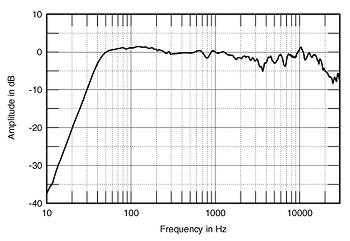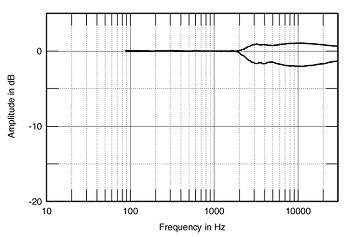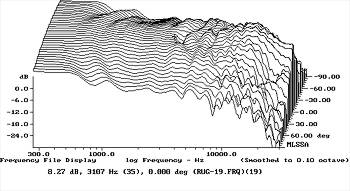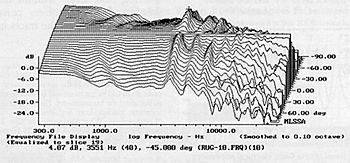| Columns Retired Columns & Blogs |
Revel Ultima Gem loudspeaker & Ultima Sub-15 subwoofer Measurements Page 3
The tweeter comes in a little higher in frequency than I would have expected. The ripples in its on-axis response are due, I assume, to reflections from the trim plates, which offer symmetrical obstructions in the tweeter's acoustic environment. These will be most severe exactly on-axis, but will tend to even out to the speaker's sides—as can be seen in fig.6, which shows the Gem's response averaged across a 30-degree horizontal window on the tweeter axis. Other than a slight lack of energy in the presence region, this is a very flat-measuring speaker! The tweeter control was again set flat for this graph. Fig.7 shows the effect of the tweeter control when set to its maximum and minimum positions, with the flat-position response subtracted out. The maximum shaping is almost exactly +1dB, -2dB, as specified.

Fig.6 Revel Ultima Gem, anechoic response on tweeter axis at 50", averaged across 30-degree horizontal window and corrected for microphone response, with complex sum of the nearfield woofer and port responses plotted below 300Hz. HF contour set to "0."

Fig.7 Revel Ultima Gem, effect on anechoic response on tweeter axis at 50" of HF contour control set to "+1" (top) and "-2" (5dB/vertical div.).
Fig.8 shows the Gem's response as it varies across a window ±90 degrees either side of the tweeter axis. The crosshair cursor is positioned on the axial trace just below the presence-region suckout. It should be easily seen that the suckout disappears relatively quickly to the sides. This is more clearly seen in fig.9, which shows just the differences in responses. The ripples in the treble obscure what is actually a fine, well-controlled lateral dispersion, which correlates with the fine imaging.

Fig.8 Revel Ultima Gem, horizontal response family at 50", from back to front: responses 90 degrees-5 degrees off-axis; on-axis response; responses 5 degrees-90 degrees off-axis.

Fig.9 Revel Ultima Gem, horizontal response family at 50", normalized to response on tweeter axis, from back to front: differences in response 90 degrees-5 degrees off-axis; reference response; differences in response 5 degrees-90 degrees off-axis.
- Log in or register to post comments




































